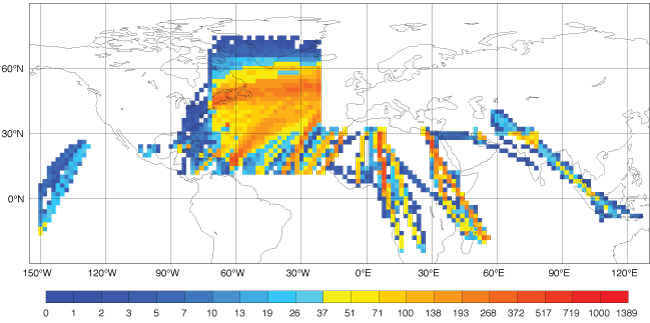

ECMWF has started to use newly available aircraft observations of humidity, temperature and wind to help initialise its forecasts.
The data come from the WMO’s Aircraft Meteorological Data Relay (AMDAR) programme.
Some of them cover parts of the globe, such as Africa, the Caribbean and ocean areas, where the observation network is relatively sparse, making them very useful to ECMWF.
A vital ingredient
Measurements of atmospheric parameters by aircraft have long been one of the sources of weather data used in numerical weather prediction.
Together with data from satellites, weather stations, radiosondes, ships and buoys, they help to determine the current state of the atmosphere. The process of merging all this information is called data assimilation.
The laws of physics are then applied to that state to predict how the weather will evolve.
Accurate and up-to-date weather observations are thus a vital part of global numerical weather prediction.

Aircraft weather observations are concentrated in particular parts of the globe and only cover the altitudes at which the aircraft fly. The map shows the locations of aircraft observations assimilated at ECMWF. The colours give an indication of the number of measurements per 1°x1° square across the atmosphere for the period 19 March to 19 May 2016.
Humidity
Since the introduction of a new model cycle on 8 March 2016, ECMWF has been using humidity data from commercial aircraft reporting via the AMDAR programme.
About 11% of AMDAR reports include a usable humidity value, mainly from US aircraft but also a few from European airlines. The aircraft involved have a diode laser instrument installed, which can measure the amount of water vapour in the air.
EUMETNET, a grouping of 31 European national meteorological services which cooperate in activities including observing systems, runs the EUMETNET-AMDAR programme.
Early in 2016, the EUMETNET-AMDAR humidity sensors were upgraded, and monitoring in ECMWF’s forecasting system helped in the early diagnosis of problems. The sensors now provide very good quality data.
Temperature and wind
Earlier this year, work by the WMO, EUMETNET-AMDAR and Météo-France resulted in 70 Air France and 60 British Airways Boeing 777 aircraft providing AMDAR data. In part these are replacing older aircraft, but there are also new routes over several data-sparse areas of the globe.

The map shows the locations of AMDAR aircraft wind measurements recently made available from Air France and British Airways Boeing 777 aircraft and assimilated at ECMWF. The colours give an indiation of the number of measurements in the upper troposphere (above 400 hPa) per 2°x2° square for the period 9 March to 25 April 2016.
These reports include wind and temperature but not humidity information. To make the best use of the communication costs involved, these aircraft do not report over Europe, which is already densely observed, but do report over Africa, the Caribbean and ocean areas.
Over the last few years there has been a significant increase in the number of AMDAR reports, coming primarily from US-based aircraft.
“Weather observations come from many different sources, which complement each other. They help us build the best possible estimate of the state of the atmosphere at any given time. The increasing availability of high-quality AMDAR aircraft data is therefore very welcome, especially over Africa, where the maintenance of traditional observing systems is both challenging and expensive,” said Erik Andersson, the Acting Director of ECMWF’s Forecast Department.
The AMDAR observing system is part of the WMO’s Global Observing System. It uses predominantly existing aircraft on-board sensors and communications systems to collect, process, format and transmit meteorological data to ground stations.
The global AMDAR system produces about 700,000 observations per day of air temperature and wind speed and direction as well as an increasing number of humidity and turbulence measurements.
